It’s been the worst drought that Phillip and Diana Ridge have experienced in 30 years. In the past four months, a measly 12mm of rain has fallen across their three sheep and cattle stations, spanning 100,000 hectares between Bourke and Enngonia in Western NSW.
It’s a sticky situation and competition for feed is only mounting, with the impact of pests and sprawling weeds choking productivity. This pressure is causing immeasurable pain for landholders’ back pockets. How on earth can you make a dollar with this sort of problem in your backyard?
Phillip hopes the answer to that question lies in exclusion fencing. With advances in customised machinery, fencing materials and labour-efficient tools, landholders have greater opportunities to build multi-purpose fences – and justify the investment to safeguard productivity of their land.
Queensland graziers have led the charge in building exclusion fences in clusters (with neighbours), with some funding from the government. Now graziers like Phillip and Diana in the far west of NSW are building their own fences, reinforced with the expectation of a bit more bang for their buck.
EXCLUSION FENCE TO REDUCE GRAZING PRESSURE
Phillip says the 100km exclusion fence he is erecting on two of the family’s properties, Jandra and Nulty, is designed to tick all the boxes. The work will update the boundary fences that are in great need of repair and, by making the new fence a little bit higher at 1.8m, he will be able to reduce grazing pressure from kangaroos, the wild dog predation of sheep and the spread of woody weed – so he says it’s worth the investment.
But most importantly, the fence will open the door for a new business venture, one Phillip says will survive any king drought: “Breeding goats behind the wire.”
“We were already going to build a fence and it was only 30-40% more to build an exclusion hinge joint fence [compared to a standard goat-proof fence]. This will eliminate kangaroos and dogs, so we expect to see the benefits in the short term. A lot of the fencing is past its use-by-date and in terms of economics, with the rising sheep and goat values, people are finally able to afford to replace their fencing.”
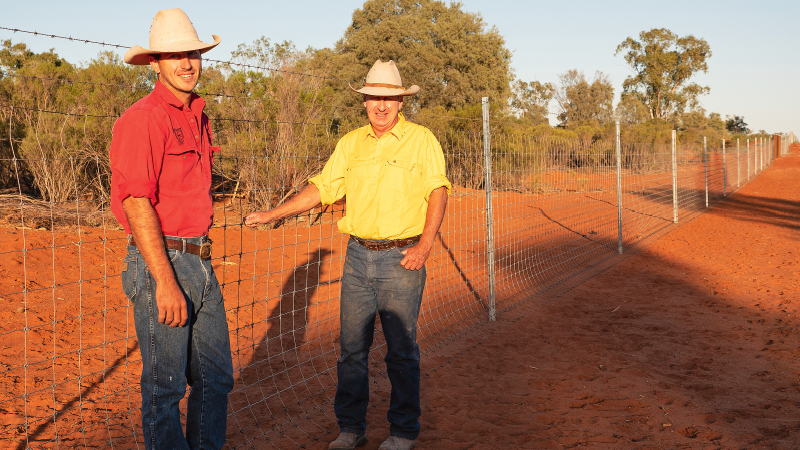 Richard Ridge and father Phillip Ridge on the fence line.
Richard Ridge and father Phillip Ridge on the fence line.
Phillip says they’ll have enough of the fence completed by winter to start running rangeland goats. It’s good timing – the new $60 million Bourke small livestock abattoir is set to begin processing this year.
“We can’t do [the fence] all in one go, you’ve got to do it bit by bit. There’s a lot of logistics in getting it ready.” Phillip says there have been big advances in fencing.
“It’s different to many years ago. We have heavy machinery to clear the fence line that has made that job far better, plus new designs of the fences and the materials. You used to have to run miles of wires through the fence,” he says. But that’s changed with the latest fencing gadget, a Fastfencer.
CLEVER CONSTRUCTION CUTS FENCING TIME IN HALF
A Fastfencer is a clever contraption that side-clamps to a tractor and speeds up the cumbersome unrolling and tensioning of wire netting. Carrying up to three rolls at a time, it’s now in high demand across western regions. Costing about $10,000, it’s been a significant investment for Phillip.
His son Richard, who’s heading up the fencing project, is excited to start using the new toy, which was delivered in mid-May. It is expected to cut fencing time by 50%.
“The Fastfencer will dramatically increase productivity and see stage one of the project done within a month of the machine being here,” Richard says. “Cost and efficiency are the main reasons we bought the machine, it makes labour a lot cheaper.”
The Fastfencer in action at Nulty station in late July. Source: Richard Ridge
On a day-to-day basis, Richard works with Bourke fencing contractors, father-son duo Geoff and Billy Brissenden, coupled with a rotation of hands when needed, including his father Phillip, Clint Hadfield, the overseer of Nulty station, and occasionally his younger brother Hugo, who studies in Sydney.
“Contractors are obviously more expensive, but in terms of efficiencies, if we had to do this all ourselves, no-one would have been able to do anything for two months, because we’ve had weeks of sheep work to do,” Richard says.
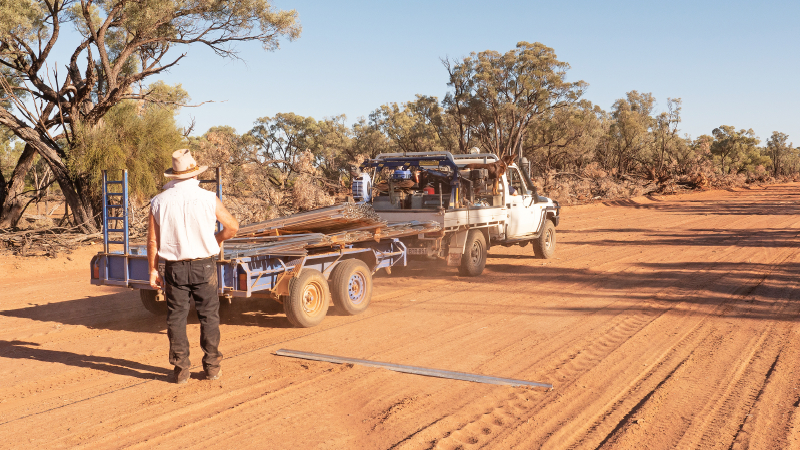 Geoff Brissenden prepares steel posts ready for driving.
Geoff Brissenden prepares steel posts ready for driving.
EARLY STAGES OF THE PROJECT
The project began in January with the bulldozing of the old boundary fence, followed by the grading of a flat pad to help create a secure barrier. Here, a 40cm apron will lie flush to the ground on the outside of the fence to close the gap, warding off unwelcome incomers and preventing stock from straying.
Geoff and Billy use a Massey Ferguson 35 tractor to drive steel posts – spaced 7m apart – into mostly hard red soil, with two barbed wire lines on the top and one on the bottom, fixed with 1.8m-high hinge joint netting. “When there’s two kilometres or more to bang out at once, Clint and I will help Geoff and Billy every fortnight, and that can take half a day,” Richard says.
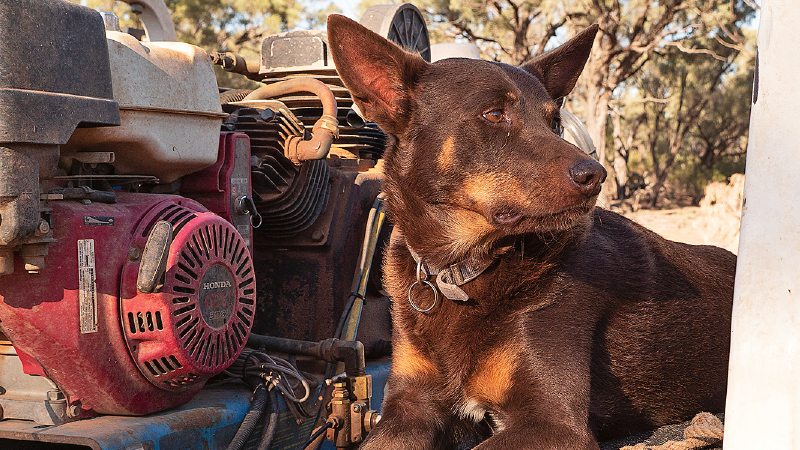
Geoff's dog Junior, joins the fencing crew on the job.
Neighbouring properties, including Toorale and Gundabooka national parks, have agreed to help out financially with adjoining fence costs. Richard says they’re using 50%
Clipex and 50%
Waratah fencing products. National parks stipulate that their portion requires Waratah fencing and, as there’s a 14-month back order for the product, they’ve had to leave that section of the fence until last.
By early May, the team had 25% of stage one of the fence line project – enclosing most of Nulty station – underway, with plans to finish this by mid winter. They aim to complete Jandra by the end of the year.
INCREASING PRODUCTIVITY OF THE LAND
“The glory of it all is you’ll be able to control the grazing pressure,” Phillip says. “In 10 to 15 years’ time, putting up an exclusion fence will be the norm, not the exception, in the Western division.”
Waratah’s NSW rural sales manager Daniel Crisp is already seeing this trend, with farmers in places like Walgett, Bourke and Mungindi building exclusion fences. He says: “Farmers can see the benefits, through increased productivity, so they are self-funding their own fences. A lot of farmers wish they’d put it up 10 years ago.”
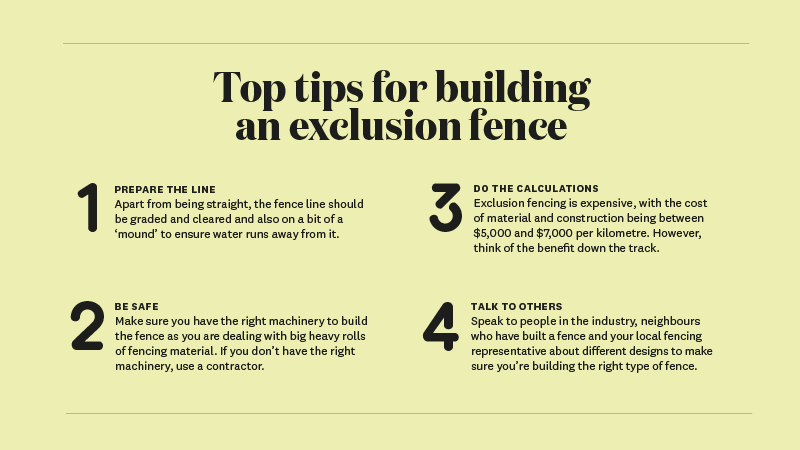 Daniel Crisp shares his advice on what makes an effective exclusion fence.
Daniel Crisp shares his advice on what makes an effective exclusion fence.
Daniel adds that farmers are building fences for total grazing management and biosecurity, not just to exclude pests. He says exclusion fences stop diseases being carried to livestock by feral animals, they keep out wild dogs, prevent feral pests like pigs damaging crops and pasture, and prevent weeds being spread by animals crossing boundaries.
“Farmers are able to improve their ground cover, because they aren’t feeding as many of the neighbours’ pests or those from national parks,” Daniel says.
PROTECTING PRECIOUS LIVESTOCK
According to a 2016 Kondinin Group research report on exclusion fencing, the fences are so effective in preventing wild dog attacks that some graziers have seen their lambing percentages go from 10% to as high as 95%. They have also reduced grazing pressure by managing kangaroo numbers.
The Ridge family runs 11,000 Merino sheep and a handful of Angus cows crossed with Wagyu bulls, and Phillip says the increasing problems caused by wild dogs is a disaster for sheep producers.
“There’s about 70,000 to 80,000 acres [28,000-32,500ha] of our timbered country prone to wild dogs now and lambing percentages have decreased due to the increased levels of stress. In a few instances we’ve seen firsthand evidence of mauled sheep with facial and tail injuries.”
“Friends to the west of us just caught five dogs, and another near Bourke caught two dogs in the past two weeks. It’s a growing problem on our doorstep, but we might be ahead of them encroaching on our land by building a fence like this.”
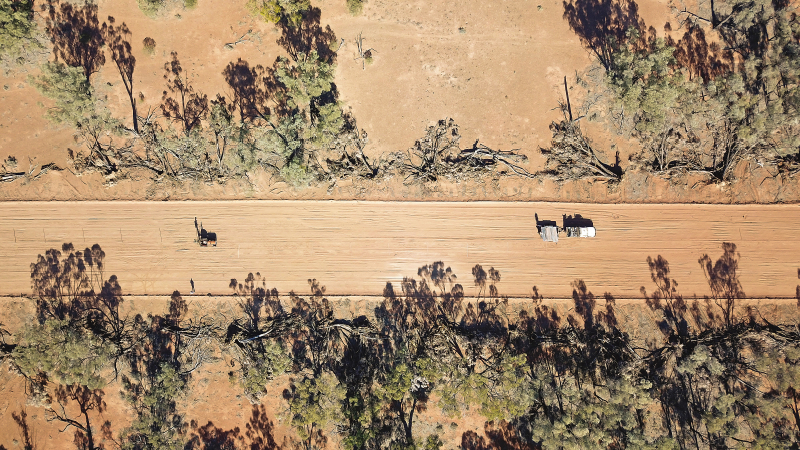 DRY RUN: Phillip Ridge believes exclusion fencing will become the norm in 10-15 years, as a means of increasing productivity, particularly in drought.
DRY RUN: Phillip Ridge believes exclusion fencing will become the norm in 10-15 years, as a means of increasing productivity, particularly in drought.
Phillip makes it clear that cattle are more of a side opportunity to their sheep: “Because when you run into a king drought, things go sideways.” He says there’s rising competition with kangaroos and less edible vegetation from the spread of woody weed.
“Nothing eats woody weed, it germinates, grows in a drought and competes with edible vegetation for livestock. With the last three droughts we’ve had in the Western division, we’ve gone into [drought] several months earlier than we needed to because of kangaroos grazing pasture.”
To quantify the damage, the Kondinin Group report says one kangaroo has a dry sheep equivalent of 0.625, so 1,000 roos will eat as much as 625 sheep.
“This is where restrictive fencing has enabled landholders to hold onto the last bit of pick they have to feed their livestock, especially in times of extreme drought,” Phillip says. “The greatest advantage with exclusion fences is when it rains – that’s when you get your biggest bang for your buck.”
*For more stories on innovation during dry times, read about the young farmer who’s creating drought lifesavers from the back of his shed and helping others cut feed costs.
GOAT VALUES SET TO RISE
Phillip says everyone rubs their hands together at the smell of goats, but the great deserts of the world were started by goats, so conservation is important.
”Our aim is to preserve the country by controlling the numbers of goats, not allowing degradation of the land,” he says.
Richard adds: “The goat prices are strong, they’ve gone up 25% in the last year and the outlooks are good for both wool and sheepmeat. If the value of everything was going down you wouldn’t want to do this – you wouldn’t think it was worthwhile.”
He says there have been some challenges so far, battling the heat and the “bloody flies”. “But I’m excited for completion, not only for the work to be done but to implement everything we’re aiming for.”
PROJECT OVERVIEW
NULTY & JANDRA STATION EXCLUSION FENCE